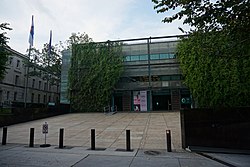
Back علاقات فنلندا الخارجية Arabic Suomen ulkopolitiikka Finnish Politique étrangère de la Finlande French Finlands utenriks- og sikkerhetspolitikk NB Внешняя политика Финляндии Russian Міжнародні відносини Фінляндії Ukrainian فن لینڈ کے خارجہ تعلقات Urdu
This article's factual accuracy may be compromised due to out-of-date information. (January 2012) |
 |
|---|

The foreign relations of Finland are the responsibility of the president of Finland, who leads foreign policy in cooperation with the government. Implicitly the government is responsible for internal policy and decision making in the European Union. Within the government, preparative discussions are conducted in the government committee of foreign and security policy (ulko- ja turvallisuuspoliittinen ministerivaliokunta), which includes the Prime Minister and at least the Minister of Foreign Affairs and the Minister of Defence, and at most four other ministers as necessary.[1] The committee meets with the President as necessary. Laws concerning foreign relations are discussed in the parliamentary committee of foreign relations (ulkoasiainvaliokunta, utrikesutskottet). The Ministry of Foreign Affairs implements the foreign policy.
During the Cold War, Finland's foreign policy was based on official neutrality between the Western powers and the Soviet Union, while simultaneously stressing Nordic cooperation in the framework of the Nordic Council and cautious economic integration with the West as promoted by the Bretton-Woods Agreement and the free trade treaty with the European Economic Community. Finland shares this history with close neighbour Sweden, which Finland was a part of until the split of the Swedish empire in 1809. Finland did not join the Soviet Union's economic sphere (Comecon) but remained a free-market economy and conducted bilateral trade with the Soviet Union. After the dissolution of the Soviet Union in 1991, Finland unilaterally abrogated the last restrictions imposed on it by the Paris peace treaties of 1947 and the Finno-Soviet Agreement of Friendship, Cooperation, and Mutual Assistance. The government filed an application for membership in the European Union (EU) three months after the dissolution of the Soviet Union and became a member in 1995. Finland did not attempt to join NATO, even though post-Soviet countries on the Baltic Sea and elsewhere joined. Nevertheless, defence policymakers quietly converted to NATO equipment and contributed troops.
President Martti Ahtisaari and the coalition governments led Finland closer to the core EU in the late 1990s. Finland was considered a cooperative model state, and Finland did not oppose proposals for a common EU defence policy.[2] This was reversed in the 2000s, when Tarja Halonen and Erkki Tuomioja made Finland's official policy to resist other EU members' plans for common defense.[2] However, Halonen allowed Finland to join European Union Battlegroups in 2006 and the NATO Response Force in 2008.
Relations with Russia are cordial and common issues include bureaucracy (particularly at the Vaalimaa border crossing), airspace violations, development aid Finland gives to Russia (especially in environmental problems that affect Finland), and Finland's energy dependency on Russian gas and electricity. Behind the scenes, the administration witnessed a resurrection of Soviet-era tactics as recently as 2017. The Finnish Security Intelligence Service, the nation's security agency, says the known number of Russian agents from Foreign Intelligence Service (SVR) and GRU now exceeds Cold War levels and there are unknown numbers of others.[3] Russian Foreign Ministry spokeswoman Maria Zakharova said in March 2022 that her government would have to respond if Finland became a NATO member.[4]
As of March 2011 Finland maintains diplomatic relations with all UN member states.[5]
All NATO countries approved Finland's accession to the military alliance by April 1, 2023, and it officially joined on April 4. The move was the final process in Finland's transition from conducting a foreign policy of neutrality to clearly standing as an official part of the Western bloc.
- ^ "Cabinet Committees". Archived from the original on January 16, 2009. Retrieved October 26, 2008.
- ^ a b "Finland's foreign policy idea" Archived December 17, 2008, at the Wayback Machine ("Suomen ulkopolitiikan idea"), Risto E. J. Penttilä, 2008
- ^ "Helsinki again a centre of international espionage". Hs.fi. Archived from the original on June 6, 2012. Retrieved December 24, 2017.
- ^ "Russia Sends Bone-Chilling Message To Sweden & Finland; Threatens 'Military Implications' If They Go The Ukraine Way". The EurAsian Times. February 25, 2022.
- ^ "Diplomatic relations established between Finland and Kiribati". Formin.finland.fi. Archived from the original on October 23, 2017. Retrieved December 24, 2017.